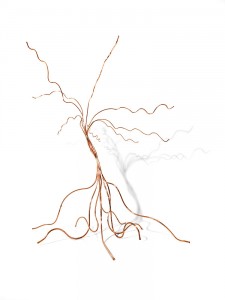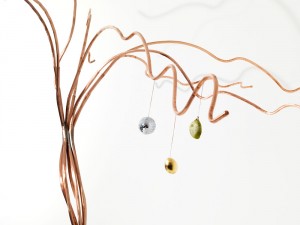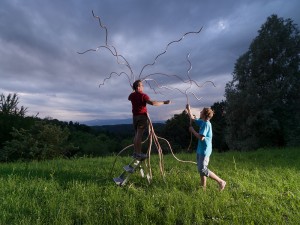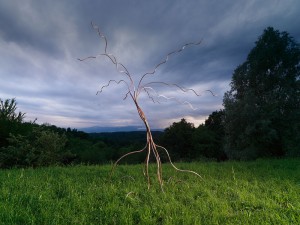Strange Fruit (from a Wandering Tree)
 Here are the intial photos from Croce und Wir of the tree for the installation Strange Fruit (from a Wandering Tree). This 3.5-4 meter tall symbolic tree has been fashioned from formed copper tubing from whose branches will hang “Strange Fruit” consisting of photographic elements and small gilded objects.
Here are the intial photos from Croce und Wir of the tree for the installation Strange Fruit (from a Wandering Tree). This 3.5-4 meter tall symbolic tree has been fashioned from formed copper tubing from whose branches will hang “Strange Fruit” consisting of photographic elements and small gilded objects.
In cooperation with the Academy for Applied Photography in Graz (A), the installation will travel through cities, towns and countrysides throughout America, Europe and Australia distributing its fruit as well as collecting personal interpretations of “Strange Fruit”.
The photographs explore in individualistic ways diverse interpretations regarding “Strange Fruit” from the figurative to the gender-specific, the mythological to the socio-political, the art historical to the intimately personal.
Special thanks to Gänsweider Metalltechnik for their support of this project.
First showing at the Academy: July 1, ’10, 8:00 pm.
New York City and Upstate: August 5-22 (details TBA)
Milan-Zurich-Munich-Salzburg-Vienna: August 27 – Sept 8, ’10
The public is invited to partake of the “fruit” of this tree, which are postcards of selected photographs.
People are encouraged to submit their own interpretations of “Strange Fruit” via an interactive website (under construction) that also provides an overview of and background to this wandering installation project along with photo and text documentation from the tree’s travels.
Today, most people associate the words “Strange Fruit” with wacky things, people or events that spice up our daily mundane routines.
60 years ago, the words “Strange Fruit” had in America a much different meaning.
During the 1940’s and 50’s, to say “Strange Fruit” immediately brought to everyone’s mind the images sung about by Billie Holiday in the song “Strange Fruit,” written as a poem by Abel Meeropol in the mid-1930’s to express his horror of the repeated incidents of black men being lynched throughout America.
Under the pen name Lewis Allan, he published the poem in 1936 in The New York Teacher, a union magazine. He later set Strange Fruit to music himself and the song gained a certain success as a protest song in and around New York.
 Barney Josephson, founder of Café Society in Greenwich Village, New York’s first integrated nightclub, heard the song and introduced it to Billie Holiday, who first performed the song at Cafe Society in 1939.
Barney Josephson, founder of Café Society in Greenwich Village, New York’s first integrated nightclub, heard the song and introduced it to Billie Holiday, who first performed the song at Cafe Society in 1939.
Times have changed in many ways from 1939 and for many younger generations the expression “Strange Fruit” is no longer directly associated with Billie Holiday’s song and its brutal imagery.
On a reflective level, Strange Fruit (from a Wandering Tree) regards the progression of human equality in general by focusing upon the transition of the meaning and connotations evoked by the two words: “Strange Fruit”.
 The juxtaposition of the visual imagery from the original 1936 poem/song with the visual interpretations of “Strange Fruit” submitted by contemporary visual artists and photographers offers a new perspective from which to regard current incidents of racial tension which continue to erupt around the world.
The juxtaposition of the visual imagery from the original 1936 poem/song with the visual interpretations of “Strange Fruit” submitted by contemporary visual artists and photographers offers a new perspective from which to regard current incidents of racial tension which continue to erupt around the world.


